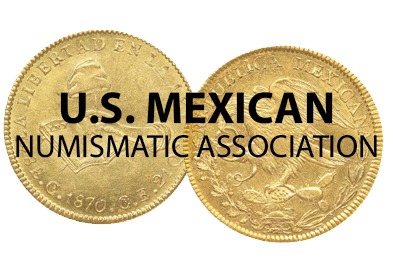Ignacio López Rayón’s paper currency
It is well-known that the Insurgents in the War of Independence produced their own coinage but, in the account of Ignacio López Rayón’s war record known as the Diario Rayónin full Diario de gobierno y operaciones militares de la secretaría y ejército al mando del excelentísimo señor presidente de la suprema junta y ministro universal de la nación, licenciado don Ignacio López Rayón it is recorded that due to the shortage of small change and the difficulty in acquiring the dies to mint coins, on 15 August 1812 Rayón published decree [text needed] authorising the provisional issue of paper currency in the three denominations of half real, one real and two reales. They were to have contraseñas (distinguishing marks) to prevent counterfeiting and people who refused to accept them, hid their goods, altered their prices or took these vales at a discount were to be punishedPara ocurrir a los perjuicios que experimentan las tropas y el vecindario por la escasez de numerario menudo, se publicó un bando para que circulasen provisionalmente unas monedas vales, de medios, reales y dos reales, impresas en papel, con sus respectivas contraseñas, para que no puedan ser falseadas, hasta que se concluyan los cuños que se están abriendo para sellar las de metal; y para que produjese toda su utilidad esta providencia benéfica, se mandó observar, so pena de ser castigados como traidores a todos los que se nieguen a recibirlas, oculten los efectos, alteren los precios de éstos, o reciban los vales por menos de su valor, a cuyo fin se han comisionado sujetos de probidad que celen su exacto cumplimiento. (Diario Rayón, 15 August 1812).
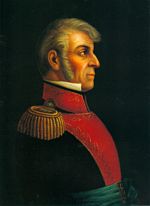 Ignacio López Rayón had been born on 31 July 1773, in the town of Tlalpujahua, Michoacán. Educated as a lawyer, during the War for Independence he served as Miguel Hidalgo’s chief of staff until Hidalgo’s capture. The Insurgent loss at the battle of Calderón Bridge on 17 January 1811 demonstrated to Rayón that large numbers of poorly armed and untrained men were not enough to defeat the Royalists and it needed an organized movement, with a professionally trained army, to achieve independence. General López Rayón served as the official head of the insurgency, as President of the Supreme Junta of the National Government from 1811 until the September 1813 Congress of Chilpancingo. Throughout his tenure he focused his efforts on uniting the Insurgents, establishing a functioning government and publishing a coherent narrative of the revolution.
Ignacio López Rayón had been born on 31 July 1773, in the town of Tlalpujahua, Michoacán. Educated as a lawyer, during the War for Independence he served as Miguel Hidalgo’s chief of staff until Hidalgo’s capture. The Insurgent loss at the battle of Calderón Bridge on 17 January 1811 demonstrated to Rayón that large numbers of poorly armed and untrained men were not enough to defeat the Royalists and it needed an organized movement, with a professionally trained army, to achieve independence. General López Rayón served as the official head of the insurgency, as President of the Supreme Junta of the National Government from 1811 until the September 1813 Congress of Chilpancingo. Throughout his tenure he focused his efforts on uniting the Insurgents, establishing a functioning government and publishing a coherent narrative of the revolution.
On 10 January 1813. López Rayón published a decree[text needed] to call in these vales, as a large number of coins were already being minted in AngangueoSe publicó un bando para recoger las monedas vales, en virtud de estarse acuñando ya en Angangueo bastante numerario menudo, y para avivar el comercio que había sufrido con aquella providencia algún entorpecimiento (Diario Rayón, 10 January 1813). So they were in circulation for four and a half months.
Rayón surrendered to the Royalists on 7 January 1817 and was condemned to die. Fortunately, he survived and was released during a general pardon in 1820. Rayón went on to serve as the State Treasurer of San Luis Potosí. He died on 2 February 1832, at the age of 58, in Mexico City.
In his January 1996 auction Dick Long offered three supposed Rayón’s notes for the sizeable sum of $10,000 to $15,000Long January 1996 auction (lot #1015.
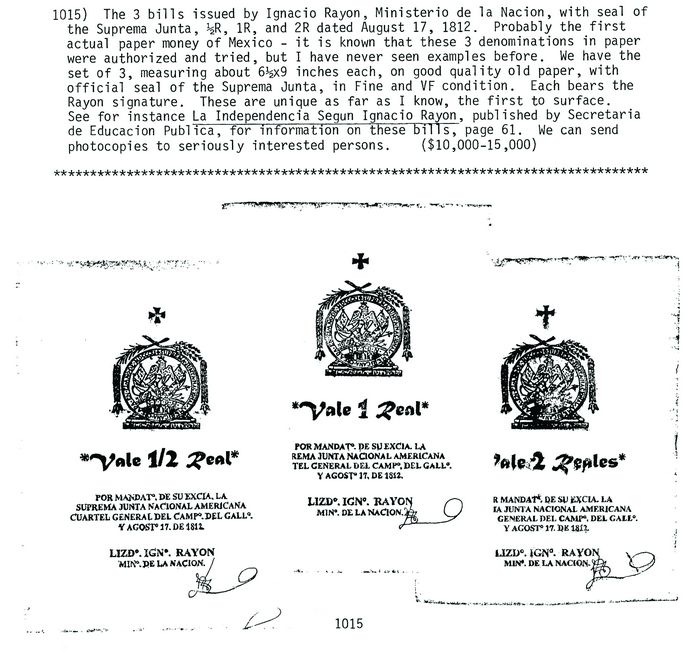
The lot was unsold, but we can examine them in detail to decide on their authenticity.
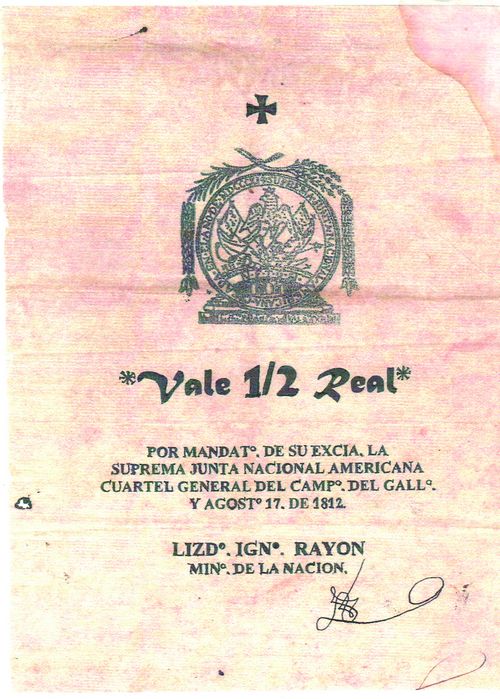
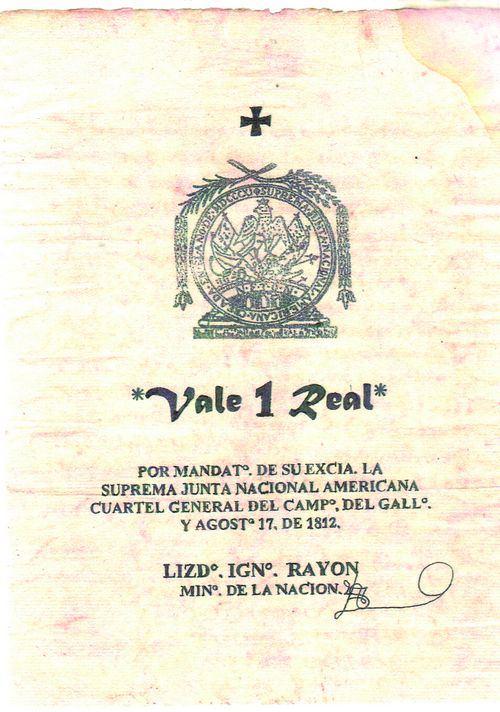
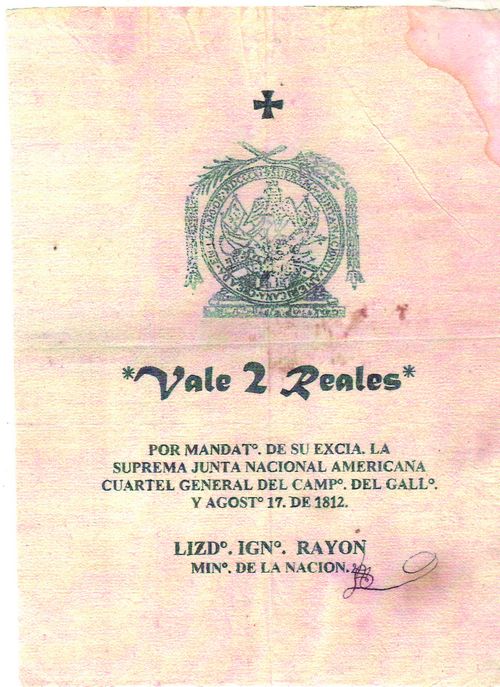
One could question their size (6½ by 9 inches) as one might expect something more like the San Miguel vales or the United States’ Continental Currency, especially when there is not much text or decoration that could impede counterfeiters, but one has to remember that the issuer might not have had any precedents from which to work.
One could be surprised that only single examples have survived, but this is not unprecedented (even for Revolutionary issues) and these might have been a “specimen” set, attached to some correspondence, and so missed the general recall. Pace Long they do not have Rayon’s signature but a truncated López (possibly as a mark of approval). Rayon’s full signature, which probably appeared on the issued notes, would have been a firmer contraseña against counterfeiting.
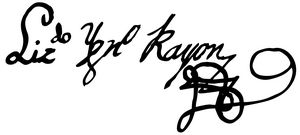
The national seal is correct. It is the one adopted on 19 August 1811 and has all the features: the “SUPREMA JUNTA NACIONAL AMERICANA CREADA EN EL ANO DE MDCCCX”, the initials “N.F.T.O.N” (for NON FECIT TALLITER OMNI NATIONE), the scrawny bird standing with both feet on a prickly pear growing on a bridge of three arches, and the branches of laurel and live oak.
However, an informed opinion of Baltazar Brito Guadarrama, the Director of the Biblioteca Nacional de Antropología e Historia, who has had the opportunity to physically examine the notes, should carry most weight. He writes:
I consider that the documents presented as the first banknotes emanating from the national independence movement are of recent manufacture. Although it is true that the material used seems to be paper corresponding to the period (nineteenth century), as it has a watermark, as well as the dots and crowns resulting from the frame used by the workman in the papermill in the process of its manufacture, there are several details that are atypical in documents of this nature:
The seals used by the Suprema Junta Nacional Americana existing in different national historical repositories are usually intagliographic, that is, they were printed by pressure exerted on a matrix containing the figure to be printed. This pressure always leaves a visible imprint around the engraving. A situation that is not observed in these documents. In fact, the stamp used on this “banknote” seems to have been made with a rubber instrument.
The typography is drawn and filled, that is, it was not printed; in addition, it does not correspond to the families of characters used by the printing presses owned by the Insurgents. This fact is especially visible in the words “vale 2 reales”.
The abbreviations do not correspond to the period. For example “Lizdo” for Licenciado (Graduate).
The flows of the rubric are perceived as imprecise and hesitant. Which means that it was not made with the ease of an original signature.
I hope that the opinion expressed in these lines is useful.
So it seems that these are later counterfeits but using paper from the period.
